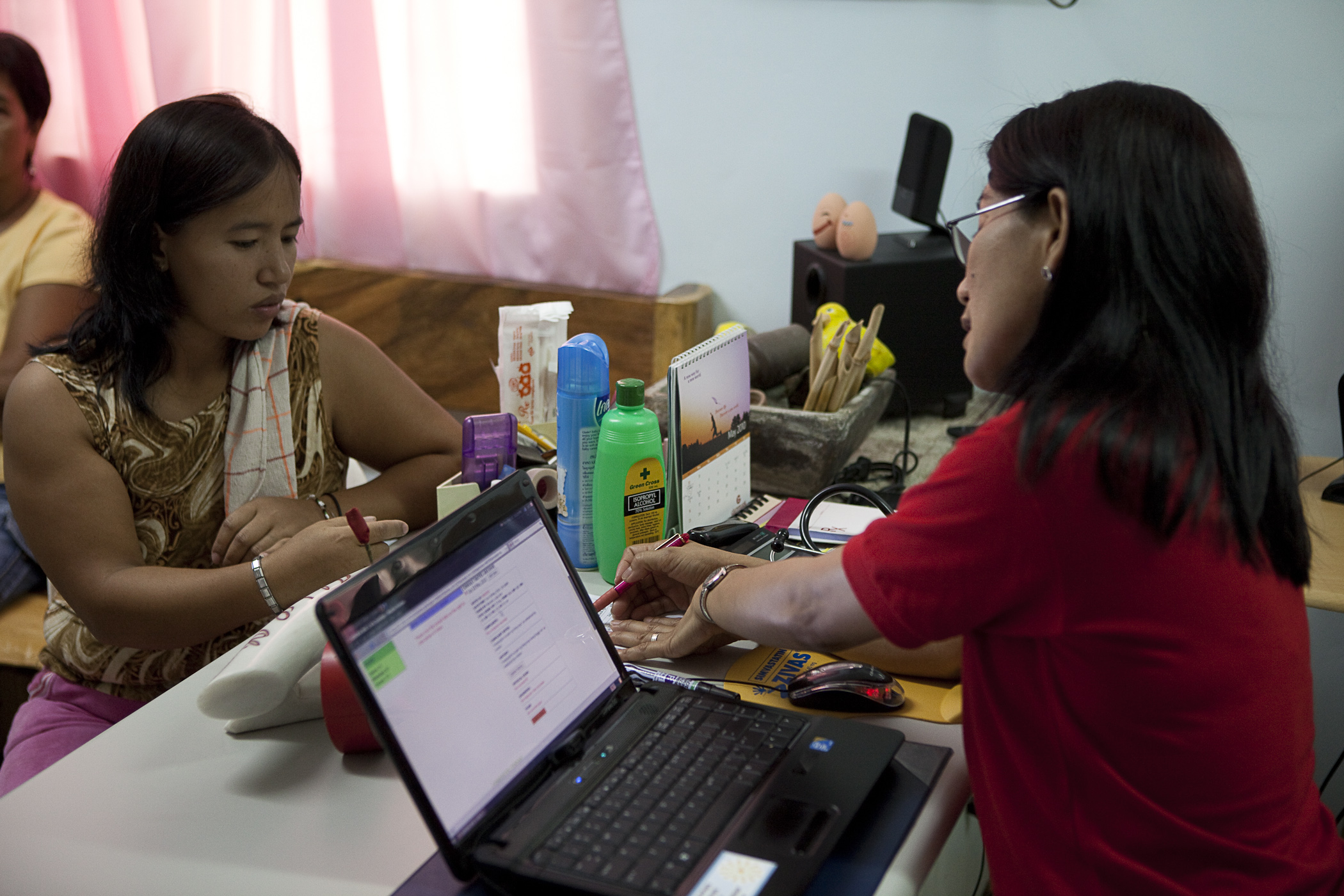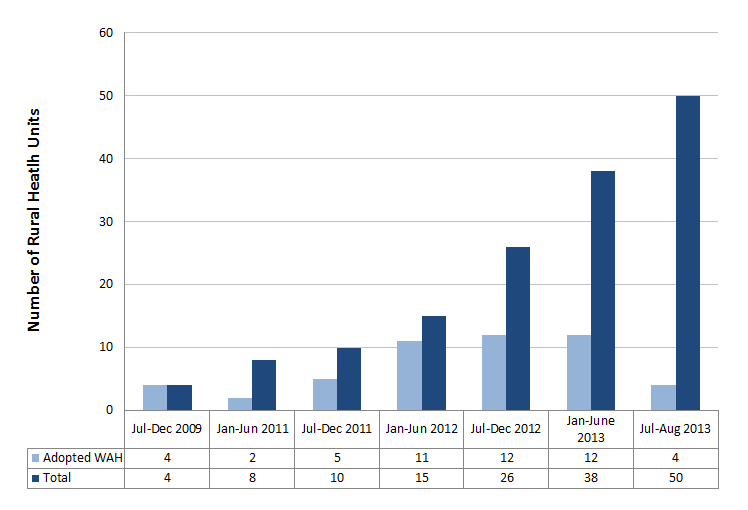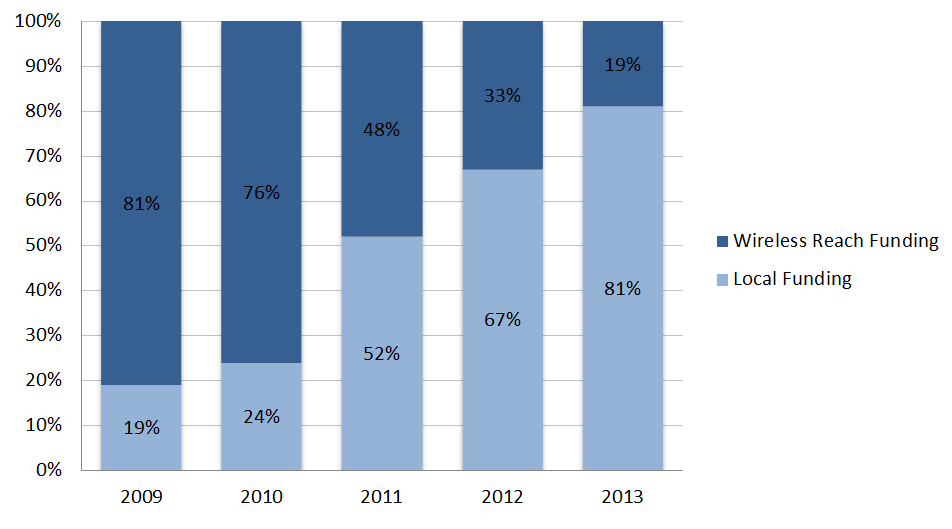Rural Health Care

Photo provided by Qualcomm Wireless Reach™
Inequity in health status and access to services is the most important health problem in the Philippines. An estimated 10.8 million poor families supported by local government units (LGUs) and the National Household Targeting System rely on Rural/City Health Units (RHUs/CHUs) and barangay (village) health stations for their primary care. There are long wait times for patients, health workers have difficulty tracking patients’ health history, and health workers spend hours on manual data recording and reporting.
When the Wireless Access for Health (WAH) partnership began in 2009 in the Tarlac Province, Central Luzon, 30% - 40% of RHUs did not submit reports to the Field Health Service Information Systems (FHSIS) on time, and there were problems with the quality of the data. National FHSIS reports took a year or more to compile using the existing partly manual system.
Solution
In 2009, RTI and our partners, Qualcomm Wireless Reach, the Tarlac Provincial Health Office, the Philippine Department of Health, Smart Communications, USAID/Philippines, Tarlac State University and the University of the Philippines-Manila National Telehealth Center, launched an innovative project to address these issues through the piloting of an electronic health record (EHR) in four Tarlac Province RHUs. The WAH program focuses on helping RHUs improve their operations and the quality of care through an innovative partnership to provide low-cost, locally built, and sustained EHR and mobile health (mHealth) tools, training, and support.
How it Works
After careful analysis, the WAH team selected the Community Health Information Tracking System (CHITS), developed by the University of the Philippines-Manila National Telehealth Center as the EHR platform for the system. CHITS had been developed with local clinicians to meet local requirements and was being used by several health centers in the National Capital Region. The WAH partnership enhanced CHITS and added new features including:
- Synchronized Patient Alerts via SMS (SPASMS), a SMS messaging system integrated with the EMR to send alerts and reminders to patients
- Mobile Midwives, a free and open source mobile application that enables midwives working outside the RHU to collect and manage patient information using mobile devices and to synchronize the records to the RHU EHR server.
- Statistics Aggregator, providing real-time access to health statistics to provincial and municipal local chief executives
- Integrated data quality checks and tools
- Electronic reporting to the DOH’s FHSIS
The resulting WAH EMR system will be able to produce electronic claims reports for the Philippines National Health Insurance Corporation, PhilHealth. The system uses 3G wireless connectivity to transmit data from RHUs to the Provincial Health Office and to the FHSIS system. The Mobile Midwives (link) application, which was built using the Coconut open source platform developed by RTI, also enables midwives to transmit and access patient data remotely via 3G while working in the community. The WAH EHR works offline, enabling each RHU to use the system even in the absence of an Internet connection.
Results
Information from WAH users confirms improved encoding, retrieval, storage, generation, and management of patient data and health information reports. Nurses and midwives who previously spent 8 to 10 hours per week manually recording and reporting patient information can now use that time for patient care.
Scaled Up
Since 2009, the WAH partnership has developed a comprehensive training approach, a broad partnership, and a team of 15 local staff. This partnership has scaled up the system from 4 pilot RHUs to all 39 RHUs in Tarlac Province. In total, the program now reaches 50 clinics in 28 municipalities, 1 city, 7 provinces and 6 regions throughout the Philippines. A system that was once a pilot program has grown to include nearly 300,000 patient records and more than 330,000 consultations.
Number of Rural Health Units Who Adopted the WAH EMR over Time

Local funding to deploy and support WAH scale-up has increased dramatically since 2009. LGUs in the Philippines have invested their own resources to adopt the WAH EHR, including purchasing computers and enabling RHU staff to attend training. This has enabled every LGU and RHU in Tarlac Province to adopt the system, and is strong evidence of its value to local government.
Percentage Increase in Local Funding for WAH 2009-2013

WAH is succeeding in scaling up because it engages stakeholders at every stage through:
- Grassroots advocacy, by engaging health workers, mayors, and provincial and regional health managers about WAH program costs and benefits.
- Partnership and affordability: WAH leverages resources from a variety of public and private partners and uses open-source software to make EHR adoption affordable.
- Continuous product improvement: Working hand-in-hand with health workers and stakeholders, such as PhilHealth and the DOH, to continue to enhance the system.
- A manageable approach: RHUs start with basic functionality and move on to more features once they have mastered each level.
- On-going support Continuing for RHUs after initial deployment including recognizing health workers’ efforts and performance
- Training and tools: Continuing training and tools to help mayors and health workers use the information produced by the EHR.
Sustained
WAH partners have created a non-governmental organization (NGO), legally recognized in June 2013, to continue to support and scale the program. The formation of an independent NGO will enable WAH to become a sustainable service in the future. WAH services will be sustained in several ways. For example, WAH may charge Local Government Units a limited fee for deployment, technical assistance and training services to pay for staff and operating expenses. In addition, WAH can raise funds and enter into partnerships with government and non-government entities to support its mission and provide additional services. WAH demonstrates how an e-health initiative can scale through partnership and strong local ownership.
Partners
Much of the success of WAH is due to its broad partnership. WAH includes local government, provincial government, regional government, national government, academic, private sector, and international partners, including the following:
- Asian Institute of Management
- Department of Health of the Philippines
- Qualcomm Wireless Reach
- Smart Communications
- Tarlac Provincial Health Office
- Tarlac State University
- University of the Philippines-Manila National Telehealth Center
- Union of Local Authorities in the Philippines
- USAID/Philippines
- Wireless Access for Health, Inc.
- Zuellig Family Foundation
Articles and Publications
- Wireless Access for Health Discussed with World Trade Organization Panel
- WAH Stakeholders' Review
- Wireless Reach Case Study
- Wireless Access for Health Informational Video
- Login to post comments
- Printer-friendly version
 PDF version
PDF version

